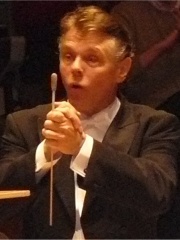
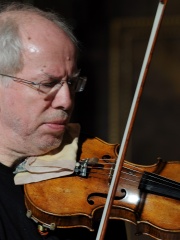
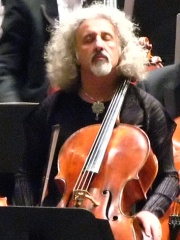
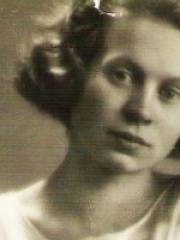
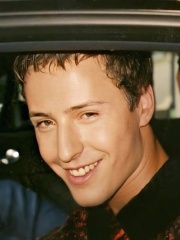
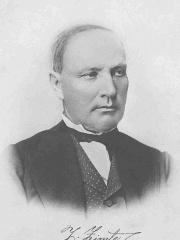
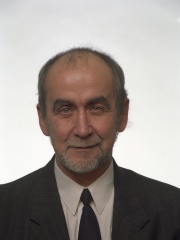
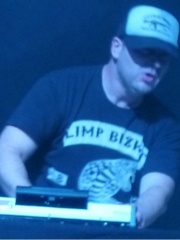
The Most Famous
MUSICIANS from Latvia
Top 9
The following people are considered by Pantheon to be the most legendary Latvian Musicians of all time. This list of famous Latvian Musicians is sorted by HPI (Historical Popularity Index), a metric that aggregates information on a biography's online popularity.

1. Mariss Jansons (1943 - 2019)
With an HPI of 71.29, Mariss Jansons is the most famous Latvian Musician. His biography has been translated into 39 different languages on wikipedia.
Mariss Ivars Georgs Jansons (14 January 1943 – 1 December 2019) was a Latvian conductor, best known for his interpretations of Mahler, Strauss, and Russian composers such as Tchaikovsky, Rachmaninoff, and Shostakovich. During his lifetime he was often cited as among the world's leading conductors; in a 2015 Bachtrack poll, he was ranked by music critics as the world's third best living conductor. Jansons was long associated with the Bavarian Radio Symphony Orchestra (BRSO; 2003–2019) and Royal Concertgebouw Orchestra (RCO; 2004–2015) as music director. Born in Riga, Latvia, Jansons moved to Leningrad (now Saint Petersburg) in 1956, where he studied conducting, and he received further training in Austria. He first achieved prominence with the Oslo Philharmonic, where he served as music director from 1979 to 2000. Besides the BRSO and RCO, he also directed the Pittsburgh Symphony Orchestra from 1997 to 2004; he was a frequent guest conductor with the London Philharmonic Orchestra and London Symphony Orchestra. Jansons recorded prolifically, and was the recipient of numerous awards.

2. Gidon Kremer (b. 1947)
With an HPI of 68.16, Gidon Kremer is the 2nd most famous Latvian Musician. His biography has been translated into 31 different languages.
Gidon Markusovich Kremer (Russian: Гидон Маркусович Кремер, Latvian: Gidons Krēmers; born 27 February 1947) is a Latvian classical violinist, artistic director, and founder of Kremerata Baltica.

3. Mischa Maisky (b. 1948)
With an HPI of 66.33, Mischa Maisky is the 3rd most famous Latvian Musician. His biography has been translated into 25 different languages.
Mischa Maisky (Latvian: Miša Maiskis, Hebrew: מישה מייסקי; né Mikhail Leopoldovich Maysky, Russian: Михаил Леопольдович Майский; born 10 January 1948) is a Soviet-born Israeli cellist.

4. Lūcija Garūta (1902 - 1977)
With an HPI of 60.10, Lūcija Garūta is the 4th most famous Latvian Musician. Her biography has been translated into 27 different languages.
Lūcija Garūta (14 May 1902 – 15 February 1977) was a Latvian pianist, poet and composer. She is mostly known for composing the cantata Dievs, Tava zeme deg! in 1943.

5. Arvīds Jansons (1914 - 1984)
With an HPI of 59.27, Arvīds Jansons is the 5th most famous Latvian Musician. His biography has been translated into 18 different languages.
Arvīds Jansons (10 October 1914 – 21 November 1984) was a Latvian conductor and father of conductor Mariss Jansons. Jansons was born in Liepāja. He studied violin from 1929 until 1935 at the Conservatory of Liepāja, then composition and conducting (under Leo Blech) at the Conservatory of Riga from 1940 until 1944 while working as violinist at Riga Opera. In 1944 he was appointed conductor of Riga Opera, then of the Latvian Radio Orchestra (1947–1952). In 1952 he was appointed reserve conductor, and tour conductor, of the Leningrad Philharmonic behind Yevgeny Mravinsky and Kurt Sanderling. Jansons became principal guest conductor of the Hallé Orchestra in 1965. He collapsed and died from a heart attack in 1984 while conducting a concert with the Hallé in Manchester. He is buried next to Karl Eliasberg in Volkovo Cemetery, Saint Petersburg.

6. Vitas (b. 1979)
With an HPI of 56.99, Vitas is the 6th most famous Latvian Musician. His biography has been translated into 38 different languages.
Vitaliy Vladasovich Grachev or Vitaliy Vladasovych Grachov, known professionally as Vitas (Russian: Витас [ˈvʲitəs]; stylised in all caps; born 19 February 1979), is a Russian–Ukrainian singer. Vitas is known for his falsetto and his eclectic musical style, which incorporates elements of operatic pop, techno, dance, classical, jazz, and folk. Vitas became popular in Russia and other Eastern European countries in the early 2000s and also achieved success in Asia, including China, in 2005. He won the ZD Awards and participated in many Russian and European music festivals, including the festival “Christmas Meetings of Alla Pugacheva” and others. He performed in a duet with Demis Roussos and Lucio Dalla. Much of his recognition outside Russia and Asia came in the 2010s, when songs such as "Opera #2" and "The 7th Element" (both from his 2001 debut album Philosophy of Miracle) and "Smile!" (from his 2002 album of the same name) achieved viral success; the unusual music videos for "Opera #2" and "The 7th Element" have been cited as the most prominent examples of this. Vitas has performed with entertainment labels such as Universal Music Group, and has toured extensively in several countries. He designs his own stage costumes, and employs a backing band named DIVA during live performances.

7. Jānis Cimze (1814 - 1881)
With an HPI of 55.97, Jānis Cimze is the 7th most famous Latvian Musician. His biography has been translated into 19 different languages.
Jānis Cimze (3 July/21 June 1814 — 22 October/10 October 1881) was a Latvian pedagogue, collector and harmoniser of folk songs, organist, founder of Latvian choral music and initiator of professional Latvian music. He is buried at the Lugaži Cemetery.

8. Imants Kalniņš (b. 1941)
With an HPI of 54.25, Imants Kalniņš is the 8th most famous Latvian Musician. His biography has been translated into 15 different languages.
Imants Kalniņš (born 26 May 1941) is a Latvian composer, musician and politician. Having studied classical and choral music, he has written seven symphonies, several operas (including the first rock opera in the USSR, Ei, jūs tur!), oratorios, cantatas, choir songs, a lot of movie and theater music. However, he is generally best known for his rock songs. In 2021, Kalniņš received the Grand Music Award for lifetime achievement. Furthermore, he served as a member of the 5th, 7th, 8th, and 9th sitting of the Saeima, the parliament of Latvia, from 1993 to 1995 and again from 1998 through 2010, representing the For Fatherland and Freedom/LNNK party.

9. DJ Lethal (b. 1972)
With an HPI of 49.46, DJ Lethal is the 9th most famous Latvian Musician. His biography has been translated into 22 different languages.
Leor Dimant (Latvian: Leors Dimants, Russian: Леор Григорьевич Димант, [lʲɪˈor grʲɪˈɡorʲjɪvʲɪd͡ʑ‿dʲɪˈmant]; born December 18, 1972), better known as DJ Lethal, is a Latvian-American DJ, musician, and record producer, best known as a member of the groups House of Pain and Limp Bizkit.
People
Pantheon has 9 people classified as Latvian musicians born between 1814 and 1979. Of these 9, 5 (55.56%) of them are still alive today. The most famous living Latvian musicians include Gidon Kremer, Mischa Maisky, and Vitas. The most famous deceased Latvian musicians include Mariss Jansons, Lūcija Garūta, and Arvīds Jansons.
Living Latvian Musicians
Go to all RankingsGidon Kremer
1947 - Present
HPI: 68.16
Mischa Maisky
1948 - Present
HPI: 66.33
Vitas
1979 - Present
HPI: 56.99
Imants Kalniņš
1941 - Present
HPI: 54.25
DJ Lethal
1972 - Present
HPI: 49.46
Deceased Latvian Musicians
Go to all RankingsMariss Jansons
1943 - 2019
HPI: 71.29
Lūcija Garūta
1902 - 1977
HPI: 60.10
Arvīds Jansons
1914 - 1984
HPI: 59.27
Jānis Cimze
1814 - 1881
HPI: 55.97
Overlapping Lives
Which Musicians were alive at the same time? This visualization shows the lifespans of the 4 most globally memorable Musicians since 1700.

